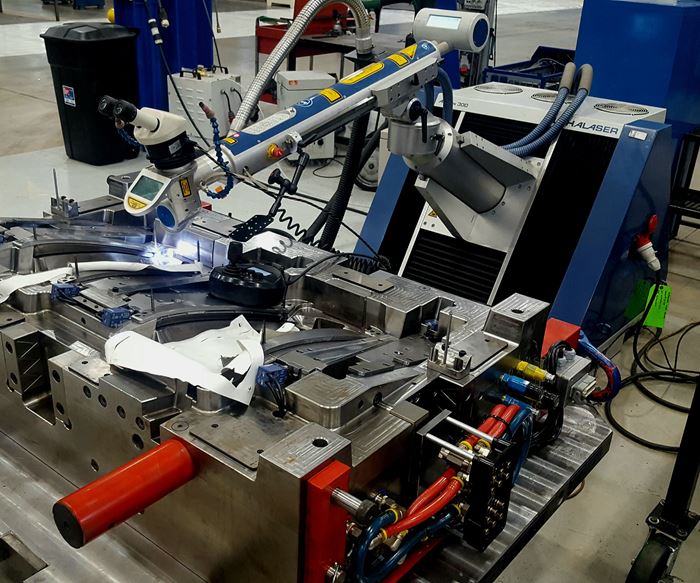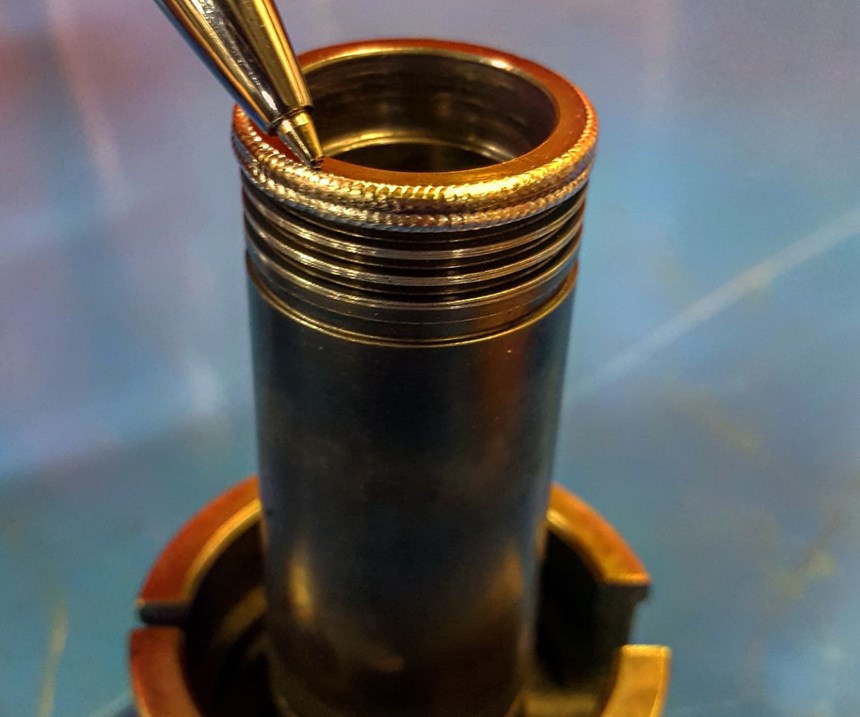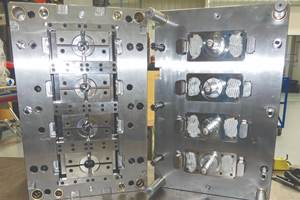Laser Welder Delivers Big on Time and Cost Savings for Small Repairs
Laser welder’s ergonomic design and functionality makes small repairs faster and easier for United Tool and Mold Inc.
Watch as United Tool and Mold's Laser Welding Operator Hunter Gibby makes fast work of repairing a rolled edge on a mold component by using the ALFlak 300 laser welder from Alpha Laser US. The whole operation, including setup, took about 20 minutes to complete.
United Tool and Mold Inc. (UTM; Liberty, South Carolina) is a 24/7 operation specializing in engineering changes and repair services for the injection- and blow-molding industries. With the motto “Keeping the Plastics Industry Running,” having the right equipment to deliver refurbished, production-ready molds to its customers quickly and efficiently is key to building customer loyalty and maintaining a thriving business.
Various processes are used in mold repair and refurbishment, including welding. UTM President Scott Phipps has no lack of skilled TIG welders among his 80 U.S.-based employees to handle big repairs on the large molds (up to 125,000 pounds). “We have to use TIG (tungsten inert gas) welding when we are putting on large amounts of steel, so we must maintain the TIG welding skills, as well as embrace the new laser technologies with the best equipment for applying small precision welds,” he explains. To wit, Phipps says he’s been amazed at the efficiencies gained and the speed of the learning curve when it comes to making smaller repairs using the ALFlak 300 Laser Welder his company purchased from Alpha Laser – US (Meadville, Pennsylvania) just over a year ago.
Superior Ergonomics
“We are probably one of the earliest adopters of laser welding in the mold industry. We started using the technology in 2005 because we do a lot of work for Germany-based BMW, which required that we laser weld their molds to reduce the risk of having heat-affected zones, and that is how we were introduced to it,” Phipps says. At the time, UTM purchased a different brand, going on the suggestion of the mold shop and the BMW people that UTM was working with.
Fast-forward to 2018, when it was determined that UTM needed to invest in a new laser welder to keep up with the workload in the Easley plant (UTM recently purchased a new facility and has consolidated two locations under one roof in Liberty, South Carolina). Phipps enlisted the help of an apprentice, Hunter Gibby, who showed an interest in laser welding technology, to research some options. Three different machines were initially considered and ultimately UTM purchased the Alpha Laser ALFlak 300, an Nd: YAG laser welding system.
The most amazing feature, and the primary reason we went with this machine, is the ergonomics of it.
“Probably the most amazing feature, and the primary reason we went with this machine, is the ergonomics of it.” Phipps says. “It is the way the arm and lens can be positioned to get into small, tight spaces without the need for the operator to fuss with adjusting the workpiece, which saves a lot of time. Plus, the lens can be moved in and out on an angle without having to reposition the arm, making it much easier to reach those tight areas, like deep ribs.”
“That feature is probably my favorite,” Gibby adds. “I don’t have to fight with the workpiece to get that visibility and see what needs to be welded. The lens on the ALFlak 300 is very flexible, meaning I can angle it from zero to 40 degrees and shoot the laser exactly where the weld should be applied. I can also twist the entire head of the arm 90 degrees, as well as rotate the laser beam 180 degrees.”
Both Phipps and Gibby attribute the ability to laser weld with such precision to the ALFlak 300’s rigidity. “It’s a very solid design, with the number of arm joints kept to a minimum so it does not vibrate when in use,” Phipps says. “Even on large, awkward fascia molds, you can position yourself comfortably in the chair while the arm reaches in to weld because the ALFlak 300’s movements and functions are easily controlled using a joy stick and foot switches.” He adds that the laser welding system’s joy stick, foot pedals and other “creature comforts” set this machine apart from most others and are worth the investment.
Gibby, who has since become UTM’s laser expert, running the ALFlak 300 eight to 10 hours a day to laser weld smaller repairs like chipped edges and corners, cracks, intricate threads and deep ribs on molds ranging between 20,000 to 50,000 pounds, couldn’t agree more. “The foot pedal is a huge advantage to this machine once you get used to it. With the pedal, I can control everything: Volts, milliseconds, hertz and spot size (weld size). The pedal consists of six different buttons or switches. For example, if I slide my foot left, my spot size will go down 0.10 mm. If I slide my foot to the right switch, it will go up 0.10 mm. It is so simple. All functions of the ALFlak can also be controlled using the button pad that is located on the unit’s arm, but once you get the hang of the foot switches and which switch controls what functions, you can be welding something and change it on the fly using your foot instead of having to stand up and make any adjustments. It becomes second nature after a while,” he says.
Faster to the Finish
Phipps points out that laser welding is not the answer for everything, but when you have smaller areas, small corners and deep ribs to weld, it is the preferred solution at UTM because it is quick and precise. “If you are building up a corner or other small area, you can apply a very small bead and then hand work or quickly machine it off without worrying about heat issues,” he says. “UTM has many good welders on staff but using traditional welding applications like TIG on small jobs can go hit or miss on heat-affected zones.”
For example, a customer recently required UTM to weld out its company logo and some words around it and re-establish the logo and wording in another location on the mold core.
Using traditional welding applications like TIG on small jobs can go hit or miss on heat-affected zones.
Phipps says the act of TIG welding itself is about four times faster than laser welding; however, there is a lot of time-consuming, upfront preparation involved, even for a small job like this. He explains what must occur: “To weld out that logo on a piece of P20 that has a high, number-two polished surface, first that block must be cleaned and then preheated to bring it up to temperature. Depending on the material and size of the block, that could be anywhere from 300 to 800 degrees F. That can take at least two to three hours using a heat plate,” Phipps says. “If any corners are cut on preheating the workpiece, the weld will show up badly in the end because of the color match, so setup time is key. Then the welder must make sure that when he applies the weld, he doesn't put too much heat into the welded area and risk compromising the color match.” Finally, blankets are used to cool the workpiece down slowly. Besides the time to get the TIG weld right, Phipps adds that it may be necessary to redo the weld two or three times to get everything matched up properly. “Realistically, you are looking at a minimum four- to five-hour process to TIG weld a project like that correctly.”
Phipps explains that, when performing small repairs, the odds of getting a good match on color and grain structure without creating a heat-affected zone are better with laser welding. “With either process, you have to do everything right or it can go wrong,” he says. “On small jobs, if you do everything right, you have about a 60 percent chance of success with TIG welding. With the ALFlak 300 laser welder, the chance of success is 80 percent or better, if you get the correct rod on the correct steel. That’s a big deal. It adds an element of security.”
Using the ALFlak 300, Gibby completed the job in an hour. He says preparation for jobs like this one entail using UTM’s chemical analyzer to determine the type of steel being welded in order to color-match the wire. Next, he chooses the correct size wire for the weld. “I have learned from the color-matching side of the process that less heat is better, so in this case I used the smallest wire possible (typically 0.010 inch).” Setting up the workpiece so that he can clearly see where to weld through the microscope is the final, and most important, step. “If I can see the weld and angle the laser directly onto the spot, I will be successful nine times out of ten, and thankfully, the ALFlak 300 offers the flexibility to get almost any spot welded. There’s really nothing else to it,” he says.
“He's welding it cool; you can touch it,” Phipps says. “He's not creating a heat affected zone. The laser welder eliminates that and the risk of transforming the steel. That workpiece can immediately go back and be benched or machined, whereas the TIG welded workpiece requires time to cool down.”
Material Concerns
UTM works primarily on the repair and maintenance of larger molds, most of which are made of materials with not more than a 50 Rockwell hardness rating. But lately, the company is seeing a few cap and closure molds, which typically require harder steels where the heat effect from TIG welding can quickly make the steel brittle and prone to chipping. This is where having the ALFlak 300 has been an advantage. “Once you get up into the D2s and A2s and the S7s and even the stainless materials, they're hardened, and their tempering is a low number,” Phipps says. “When you TIG weld these materials, you're affecting their properties and creating a brittle, white layer that breaks off very easily. But the laser welder’s temperature is so low that you are not putting any heat into the material. Instead, you're just attaching the weld to it with a 0.050-0.001-inch wire without creating that white layer that can chip off. The laser weld doesn't break off.”
New mold cooling strategies have also made the ALFlak 300 an invaluable asset at UTM, according to Phipps. “Our customers are using a lot of MoldMAX and aluminum these days to cool molds better, and this presents its own welding challenges,” he says. “These materials are designed to pull energy out of molds fast, and when they need repair, TIG welders must put a lot of energy (heat) back into the molds to be able to melt the rod — but the material is trying to pull that heat away. The laser welder doesn’t need the heat.”
Gibby concurs, saying that he frequently uses the laser welder on molds made from MoldMAX and with good results. “I hear from the TIG welders how, when they weld MoldMAX or AMPCO, they have to put so much heat into it that sometimes they can’t control the size of the weld,” he says. “I can control the ALFlak laser welder so that it makes the bead so small that heat is not an issue, and it can be hand worked off very easily.”
Phipps sums it up by saying, “It's on the little jobs that the ALFlak 300 has generated big-time savings for us.”
For More Information
Alpha Laser – US / 814-336-9000 / blair@phoenixlaser.com / alphalaser-us.com
United Tool and Mold Inc. / 864-859-8300 / scott@utminc.com / utminc.com
Related Content
How to Overcome Complex Mold Texturing Problems
Key benefits when considering laser technology for mold texturing and repair.
Read MoreThe Ins and Outs of Hot Runner Temperature Control
A training checklist that explains the why and how of proper hot runner temperature control and system management.
Read MorePrecision Welding Services Offer Rapid Turnaround Mold Repair and Reduced Molder Downtime
X-Cell Tool & Mold relies on outsourced, high-quality welding repairs from Lewis-Bawol Welding to ensure its customers' molds are back in production quickly and affordably.
Read MoreLaser Welding Versus Micro Welding
The latest battle in finely detailed restoration/repair of mold materials.
Read MoreRead Next
How to Use Continuing Education to Remain Competitive in Moldmaking
Continued training helps moldmakers make tooling decisions and properly use the latest cutting tool to efficiently machine high-quality molds.
Read MoreHow to Use Strategic Planning Tools, Data to Manage the Human Side of Business
Q&A with Marion Wells, MMT EAB member and founder of Human Asset Management.
Read MoreReasons to Use Fiber Lasers for Mold Cleaning
Fiber lasers offer a simplicity, speed, control and portability, minimizing mold cleaning risks.
Read More














.jpg;maxWidth=300;quality=90)








